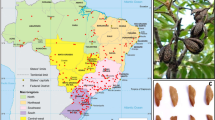Abstract
The effect of iron on root elongation and seed germination of Lactuca sativa was investigated within the limits of the plant's sensitivity to an acidic environment and iron solubility under experimental conditions. Because ionic strength was found to have phytotoxic effects, the same pH and ionic strength conditions were kept constant over the entire iron concentration range, so as to evaluate solely the effect of iron. 0.14 mM Fe3+ was found to be the lowest effective concentration inhibiting root elongation. The low solubility of iron at a pH of 3 (the lowest value which could be applied for root elongation) excluded the testing of higher iron concentrations. Due to the lower sensitivity of seed germination to acidity, a pH of 2.6 could be applied in this case. The lowest effective iron concentration (the lowest applied concentration causing a significant decrease in germination as compared to the control, P < 0.05), EC50 (the concentration at which germination was 50% of that of the control specimens) and the completely effective iron concentration (the concentration that completely inhibited seed germination) were 0.6, 0.92 and 2.0 mM, respectively.
Similar content being viewed by others
References
Banasova V and Sucha V 1998 Degradation of grassland after strong soil acidification. Ekologia (Bratislava) 17, 28–38.
Bosecker K 1997 Bioleaching: Metal solubilization by microorganisms. FEMS Microbiol. Rev. 20, 591–604.
Devare M and Bahadir M 1994 Ecotoxicological assessment of inorganic waste disposal in salt mines. Part II: Phytotoxicity tests. Fresenius Envir. Bull. 3, 119–126.
Evans L S, Gmur N F and Mancini D 1982 Effects of simulated acidic rain on yields of Raphanus sativus, Lactuca sativa, Triticum aestivum and Medicago sativa. Environ. Exp. Bot. 22, 445–453.
Kummerova M, Slovak L and Holoubek I 1995 Phytotoxicity studies of benzo [A] pyrene with Lactuca sativa. Toxicol. Environ. Chem. 51, 197–203.
Kummerová M, Slovak L, Mazankova J and Holoubek I 1996 The effect of fluoranthene on the germination of plants. Toxicol. Environ. Chem. 60, 235–244.
Samantaray S, Pani S S, Rout G R and Das P 1998 Effect of heavy metals on root growth of Italian millet (Setaria italica L.). Fresen. Environ. Bull. 7, 295–301.
Schlesinger W H 1997 Biogeochemistry. Academic Press, San Diego. 588 p.
Wheeler D M, Power I L and Edmeades D C 1993 Effect of various metal ions on growth of two wheat lines known to differ in aluminium tolerance. Plant Soil 156, 489–492.
Wheeler D M and Power I L 1995 Comparison of plant uptake and plant toxicity of various ions in wheat. Plant Soil 172, 167–173.
Author information
Authors and Affiliations
Corresponding author
Rights and permissions
About this article
Cite this article
Bartakova, I., Kummerova, M., Mandl, M. et al. Phytotoxicity of iron in relation to its solubility conditions and the effect of ionic strength. Plant and Soil 235, 45–51 (2001). https://doi.org/10.1023/A:1011854031273
Issue Date:
DOI: https://doi.org/10.1023/A:1011854031273




